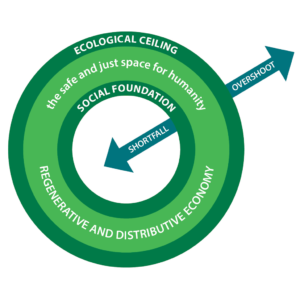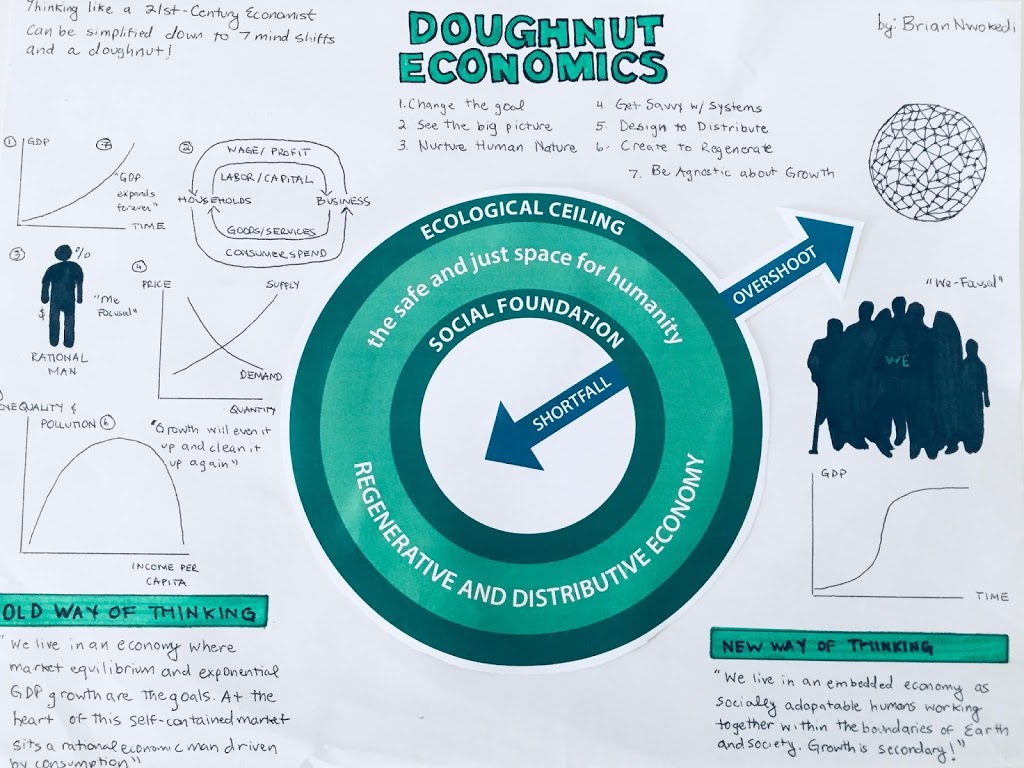Macroeconomics Explained Using Doughnuts
Matt Groening was once said, “Donuts. Is there anything they can’t do?” And for Kate Raworth, doughnutsare rewriting everything you ever learned in Economics 101. Her book, Doughnut Economics, is a simple referendum on modern day economics. Her thesis is quite simple:
Leaders of 2050 are being taught an economic mindset that is rooted in the textbooks of 1950, which in turn are rooted in the theories of 1850.
This “archaic” economic mindset has led our current world astray, and thus a new way of thinking for the 21st Century is much needed.
Enter the Doughnut
The essence of the doughnut is a social foundation of well-being that no one should fall below, and an ecological ceiling of planetary pressure that we should never go beyond. It is in between these two layers that lies a safe and just space for us all:
In order to remain within the boundaries of the doughnut, current economic thinkers and policy makers need to change their default modus operandi. Raworth identifies seven specific ways to change economic thinking and policy making for the better:
1. Change the Goal from GDP to the Doughnut
2. See the Big Picture from self-containing market to embedded economy
3. Nurture Human Nature from rational economic man to social adaptable humans
4. Get Savvy with Systems from mechanical equilibrium to dynamic complexity
5. Design to Distribute from ‘growth will even it up again’ to distributive by design
6. Create to Regenerate from ‘growth will clean it up again’ to regenerative by design
7. Be Agnostic about Growth from growth addicted to growth agnostic
The following picture is my visual representation of what Doughnut Economics represents to me.
Shifting from Conventional Economics to Doughnut Economics Will Help Planet Earth and All Humankind Thrive
The current economic pursuit of GDP first pushes every consumer in our global economy to spend money they don’t have on things they don’t really need (think consumerism 101). It’s an endless hamster wheel of more for the sake of more, and it requires continual growth in income and output to support it.
By changing the goal of our global economy from GDP to the Doughnut we ignore conventional economic theory that posits every citizen’s satisfaction or happiness is based on the consumption of more goods. And this switch in focus will allow us to better advance the richness of human life on earth.
Underlying the big shift in economic focus is another underlying shift in the characterization of humans and their nature. Conventional economic theory posits that humans are rational and make decisions that solely maximize their utility which equates to driving satisfaction through consumption.
But the reality of life for each of us is we are far from solitary figures. Instead, we are social adaptive beings that thrive best in environments where we can relate to each other. Thus, our global economic machine is best served by putting the collective “WE” at the focus instead of growth in “GDP” at the focus.
It’s Clear We Have an Economic Design Problem … The Question is Will We Fix It?
In the 21stcentury, we have transgressed at least four planetary boundaries and have created a global economy that has left billions of people still facing extreme deprivation. On top of that, the current global economy has allowed the richest 1% to own half of the world’s financial wealth.
At the heart of income and wealth inequality lies a simple design question: who owns the enterprise, and so captures the value that workers generate? Our current economic system is designed in such a way that shareholders own the enterprise and thus capture the value generated by workers as evidenced by the following:
From 2002 – 2012 worker productivity grew +30% while real wage growth remained practically non-existent. This trend was so dreadful that economists have dubbed this ten-year period the “Lost Decade for Wages.” Meanwhile, returns to shareholders grew faster than the economy as a whole.
Furthermore, it’s beyond clear now that our economic system is the actual root cause of the ecological crisis that we currently face as humankind on this Earth (see hereand here). At the heart of Earth’s ecological decline lies a simple design flaw in our current global economy:
We extract Earth’s minerals, metals, biomass, and fossil fuels and manufacture them into products. These products are eventually sold to consumers who use then but eventually throw them away. The very essence of this cradle-to-grave type industrial economic system is destructive to Earth’s ecological system.
Given the societal and ecological challenges we face, it’s up to us to decide whether or not we want to fix the economic design problem we have.
In Closing
In 2015, world GDP was $80 trillion. An expectation of 3% indefinite growth would mean that …
(1) By 2050 the world economy would be 3x bigger than 2015
(2) By 2100 the world economy would be 10x bigger than 2015
(3) By 2200 the world economy would be 240x bigger than 2015
It’s beyond clear that this expectation of indefinite growth can not be possible without destroying our Earth and society! Alarm bells should be going off in each and every one of us from citizens to politicians.
It’s time for us to accept the fact that we have reached the logical conclusion of our expansionist economic paradigm, and redesign a global economy that is focused on the promotion of human prosperity whether GDP is going up or down. This will be an extremely hard shift in paradigm, but it will be absolutely vital if we are going to make it as a planet and society for the next 100 years.
Extras
Brian Nwokedi’s Book Review on Goodreads
Brian Nwokedi’s Twitter
Direct Link to Book: Doughnut Economics
Author’s Website: Doughnut Economics
Author’s Twitter: @KateRaworth


